This pub was once Thomas Goward’s grocery shop. Founded in 1810, Goward’s traded on this site until 1910, weighing out provisions and cutting sugar by hand from a conical-shaped sugar loaf. In a warehouse behind the shop, Goward’s staff blended tea, ground coffee, chopped sugar, ground spices and washed and polished dried fruit for sale in the shop. In 1871, Goward lived over the shop in a large household, which included his wife and three daughters, three of his shop men and two domestic servants.
Prints and text about the history of this site.

The text reads: This Wetherspoon pub was once Goward’s grocery shop. Founded in 1810, Coward’s traded on site until 1910, weighing out provisions and cutting sugar by hand from a comical-shaped sugar loaf. In a warehouse behind the shop, Goward’s staff blended ten, ground coffee, chopped sugar, ground spices and washed and polished dried fruit for sale in the shop.
In 1871, Thomas Goodwin Goward lived over the shop in a large household, which included his wife and three daughters, three of his shop men and two domestic servants. He later moved out to a villa in Victoria Avenue.
Top left: Goward’s grocery shop at 18 High Street, c1890
Top right: Goward & Sons in the High Street
Left: A sugar master and sugar canes
Above: Traditional sugar production
Right: A sugar loaf and tongs.
Illustrations and text about the Civil War.
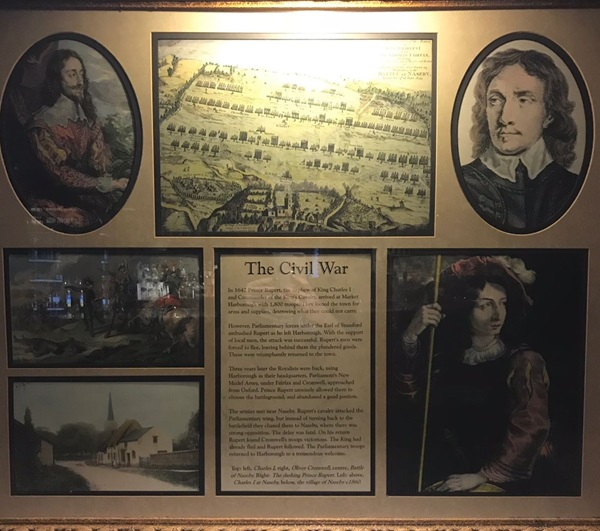
The text reads: In 1642 Prince Rupert, the nephew of King Charles I and Commander of the King’s Cavalry arrived at Market Harborough with 1,800 troops. They looted the town for arms and supplies, destroying what they could not carry.
However, Parliamentary forces under the Earl of Stamford ambushed Rupert as he left Harborough. With the support of local men, the attack was successful. Rupert’s men were forced to flee, leaving behind them the plundered goods. These were triumphantly returned to the town.
Three years later the Royalists were back, using Harborough as their headquarters. Parliament’s New Model Army, under Fairfax and Cromwell, approached from Oxford. Prince Rupert unwisely allowed them to choose the battleground, and abandoned a good position.
The armies met near Naseby. Rupert’s cavalry attacked the Parliamentary wing, but instead of turning back to the battlefield they chased them to Naseby, where there was strong opposition. The delay was fatal. On his return Rupert found Cromwell’s troops victorious. The King had already fled and Rupert followed. The Parliamentary troops returned to Harborough to a tremendous welcome.
Top: left, Charles I, right, Oliver Cromwell, centre, Battle of Naseby
Right: The dashing Prince Rupert
Left: above, Charles I at Naseby, below, the village of Naseby c1860.
A photograph and text about Thomas Cook.
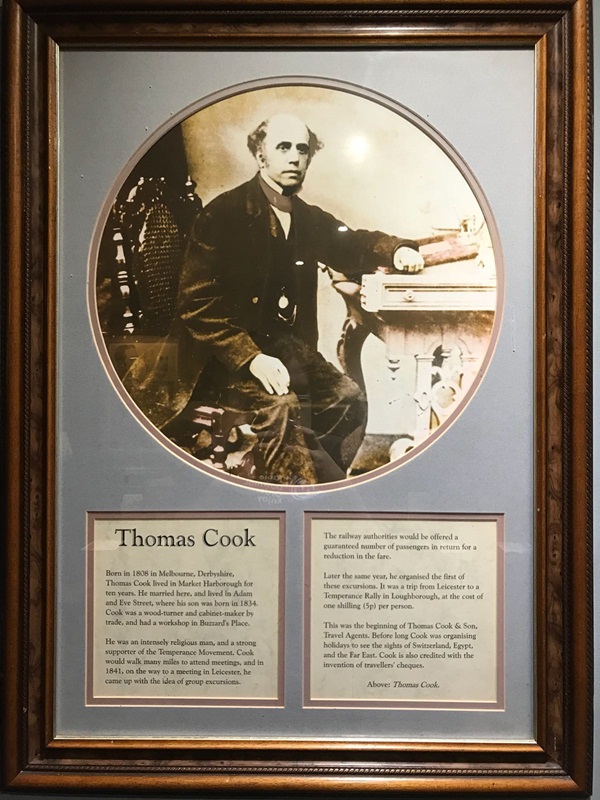
The text reads: Born in 1808 in Melbourne, Derbyshire, Thomas Cook lived in Market Harborough for ten years. He married here, and lived in Adam and Eve Street, where his son was born in 1834, Cook was a wood-turned and cabinet-maker by trade, and had a workshop in Buzzard’s Place.
He was an intensely religious man, and a strong supporter of the Temperance Movement. Cook would walk many miles to attend meetings, and in 1841, on the way to a meeting in Leicester, he came up with the idea of group excursions.
The railway authorities would be offered a guaranteed number of passengers in return for a reduction in the fare.
Later the same year, he organised the first of these excursions. It was a trip from Leicester to a Temperance Rally in Loughborough, at the cost of one shilling (5p) per person.
This was the beginning of Thomas Cook & Son, Travel Agents. Before long Cook was organising holidays to see the sights of Switzerland, Egypt, and the Far East. Cook is also credited with the invention of traveller’s cheques.
Above: Thomas Cook.
Photographs and text about the old grammar school.
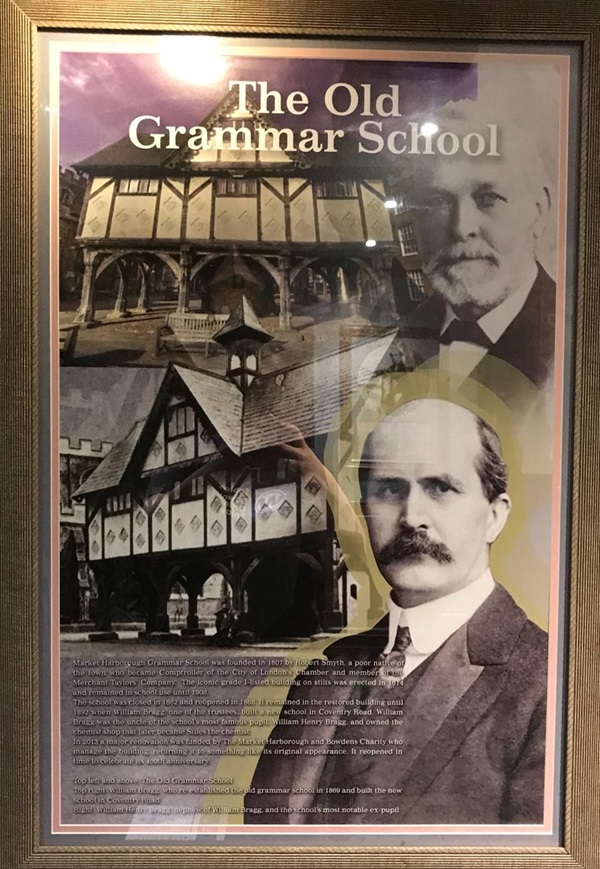
The text reads: Market Harborough Grammar School was founded in 1607 by Robert Smyth, a poor narrative of the town who became Comptroller of the City of London’s Chamber and a member of the Merchant Taylors’ Company. The iconic grade 1-listed building on stilts was erected in 1614 and remained in school use until 1908.
The school was closed in 1862 and reopened in 1868. It remained in the restored building until 1892 when William Bragg, one of the trustees, built a new school in Coventry Road. William Bragg was the uncle of the school’s most famous pupil, William Henry Bragg, and owned the chemist shop that later became Stiles the chemist.
In 2013 a major renovation was funded by The Market Harborough and Bowden’s Charity who manage the building, returning it to something like its original appearance. It reopened in time to celebrate its 400th anniversary.
Top left and above: The old grammar school
Top right: William Bragg, who re-established the old grammar school in 1869 and built the new school in Coventry Road
Right: William Henry Bragg, nephew of William Bragg, and the school’s most notable ex-pupil.
Illustrations and text about the Symington family.
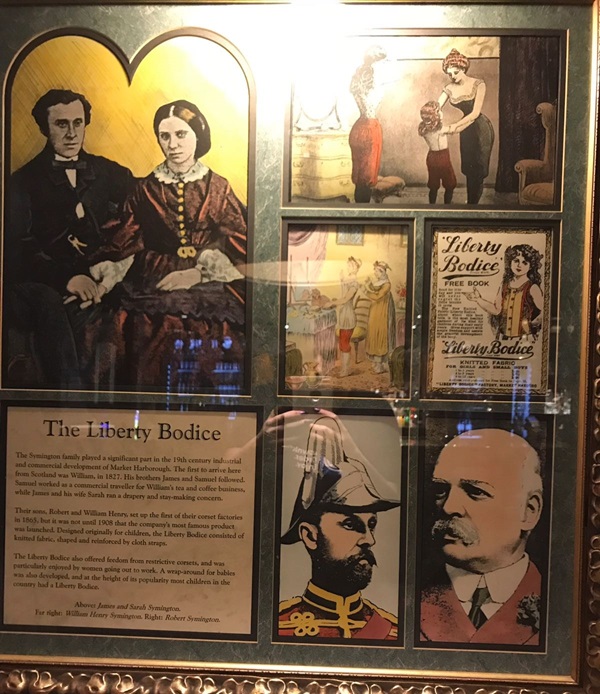
The text reads: The Symington family played a significant part in the 19th century industrial and commercial development of Market Harborough. The first to arrive here from Scotland was William, in 1827. His brothers James and Samuel followed. Samuel worked as a commercial traveller for William’s tea and coffee business, while James and his wife Sarah ran a drapery and stay-making concern.
Their sons, Robert and William Henry, set up the first of their corset factories in 1865, but it was not until 1908 that the company’s most famous product was launched. Designed originally for children, the Liberty Bodice consisted of knitted fabric, shaped and reinforced by cloth straps.
The Liberty Bodice also offered freedom from restrictive corsets, and was particularly enjoyed by women going out to work. A wrap-around for babies was also developed, and at the height of its popularity most children in the country had a Liberty Bodice.
Above: James and Sarah Symington
Far right: William Henry Symington Right: Robert Symington.
A photograph of Harborough Station, c1860.
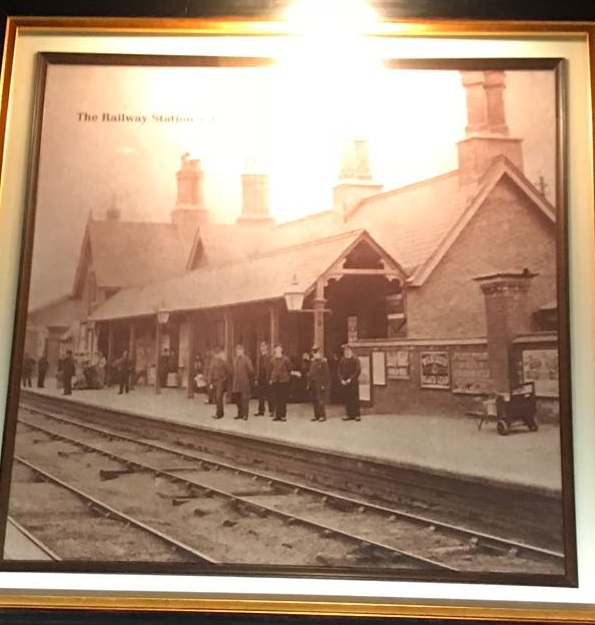
A photograph of Market Square, c1905.
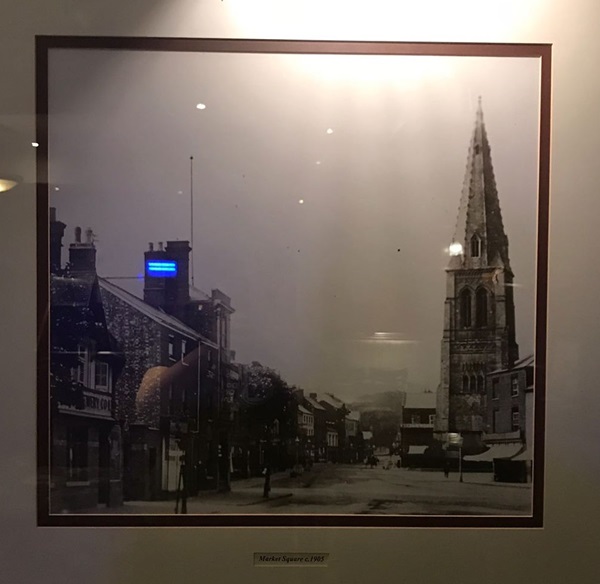
A photograph of St Dionysius Church, Market Harborough c1960.
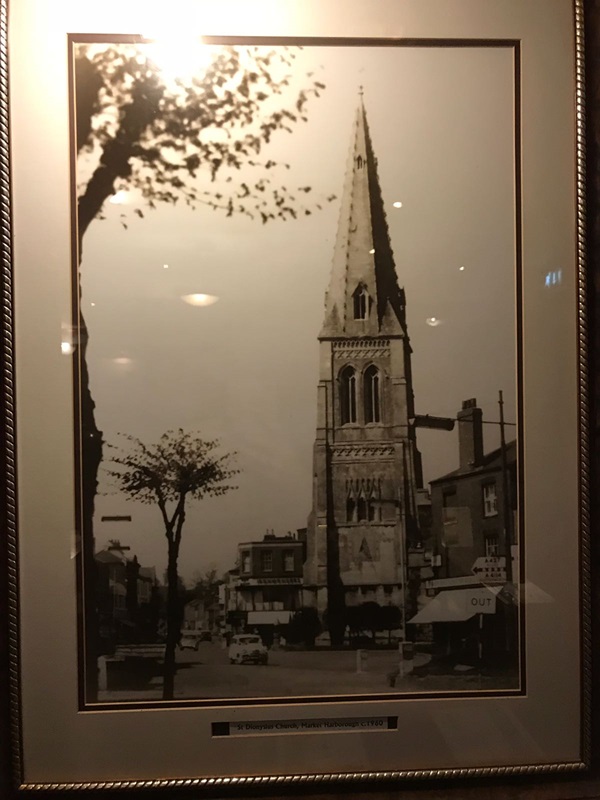
A photograph of The Square, Market Harborough, c1910.
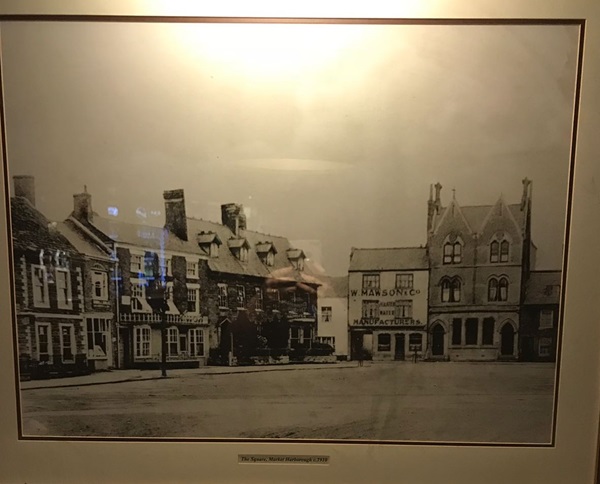
A photograph of Market Harborough, c1950.
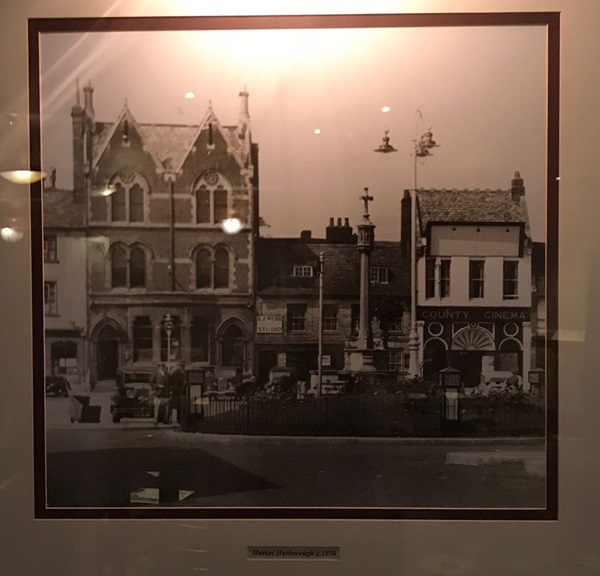
The last limited edition print of Tuesday Market, by Frank J Scott of Market Harborough.
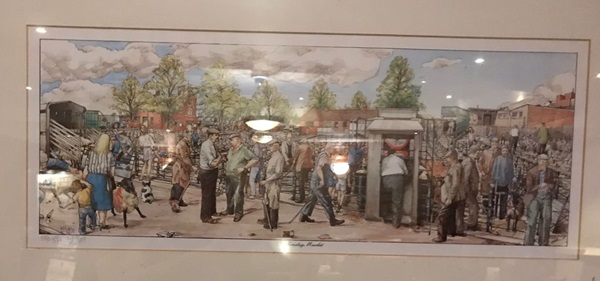
Frank J Scott was originally from Leicester, and now lives and works in Market Harborough.
He graduated from Leicester College in the 1960s with a National Diploma in Design (Graphics). After a career in industry he gained an Art Teaching Diploma (with Distinction). More recently he has worked full time on his own work and been president of the Market Harborough Art Club. His artworks are sold in many countries through a number of galleries and via his own website.
The Shop Chair.

“The shop chair regularly accommodated some fat, thin, jolly, gloomy, tired, philosophical botty or other…”
Christopher Perkins dropped in from time to time, of good family, well educated, he’d taken a turn somewhere along the line. He was tall with a bushy beard and wore a blanket tied around with binder twine, and sandals. On first appearance he looked like John the Baptist, and I expected a plague of locusts or a swarm of bees behind him.
When he had settled and arranged himself in the chair he would make a few observations, scout around his mind until he had a subject by the tail, and then hold forth. Usually some aspect of the human predicament he’d been brooding on. When he’d got it off his chest he was up and away without more ado.
One day, after a long natter Christopher asked for a pair of braces. I gasped a bit, reports a few days earlier had it that his blanket had parted in the Post Office and there was no garment beneath. What did he need braces for? He paid for them from a little purse from somewhere under the blanket.
One tall thin old fellow used to trotter in, collapse on the chair and cross his right leg over his left and finish with both feet, flat on the floor. It beats me. You try it sometime.
The golden days of the chair were when the old “country couples” came in for the annual spend up. Ma would sit placidly with her hands folded in her lap and take command, “We’ll start with his pants and vests”. Then we went on to half a dozen pairs of socks, a cardigan, a pullover, trousers, jacket, raincoat, and sometimes a suit.
Pa got absolutely just what he wanted because after each item Ma said “No is that what you like? You’ve got to wear it”. Pa said he was delighted and couldn’t compliment Ma enough on her taste and judgement. So she let him sit in the chair whilst she rattled through her handbag and paid up.
Then there was the huge man who came in and said “Hats” followed by “I’ll have that, that, and that.”, stuck ‘em all on top of the one he was wearing and marched off down the street.
A foreign gent indicated his need for a hat with a flourish of his hand and one word, “Zwind”, Oh! that more hat-wearing men would learn over Welland Bridge on a “zwindy day.”
If you have information on the history of this pub, then we’d like you to share it with us. Please e-mail all information to: pubhistories@jdwetherspoon.co.uk